New Isuzu D-Max ute review: Big upgrades push workhorse to front of the pack
Australians can’t get enough utes, and the latest example hitting our shores is sure to get the attention of tradies and outdoor adventurers.
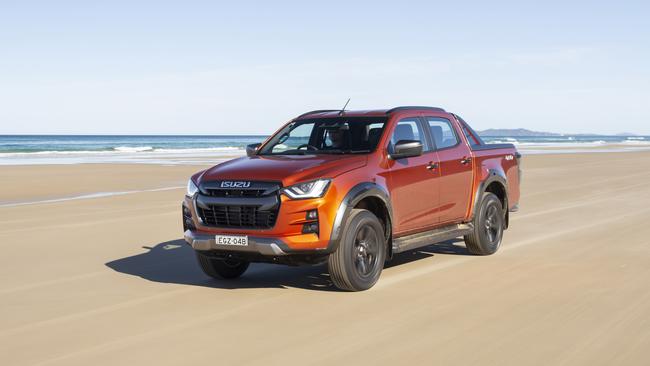
New cars
Don't miss out on the headlines from New cars. Followed categories will be added to My News.
It took just half a minute from bounding a 2021 Isuzu D-Max onto the sand for a pair of
young beach drivers to flag me down.
“Is this the new one?” the first twenty-something asked. “Okay to have a look over it?” the
second requested.
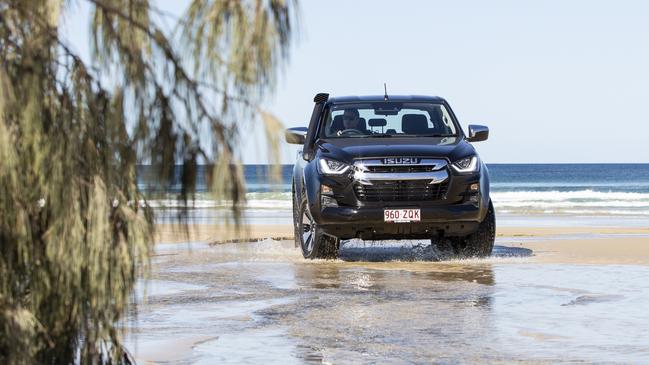
Men of this age used to ask about sportscars, but today it’s all about one-tonne utes.
So, when a new model lands – this the first all-new D-Max in eight years – interest among this buyer type is mighty.
Put two in their beach-driving playground and it’s like the Pied Piper’s arrived with a shiny
new flute.
Isuzu sells only two models in Australia – the D-Max and MU-X SUV. Even so, they shifted
over 25,000 cars last year – more than BMW or Suzuki. Isuzu’s rugged, reliable reputation strikes chords with caravan-towing grey nomads, lifestyle adventurers, worksite labourers, farmers and more.
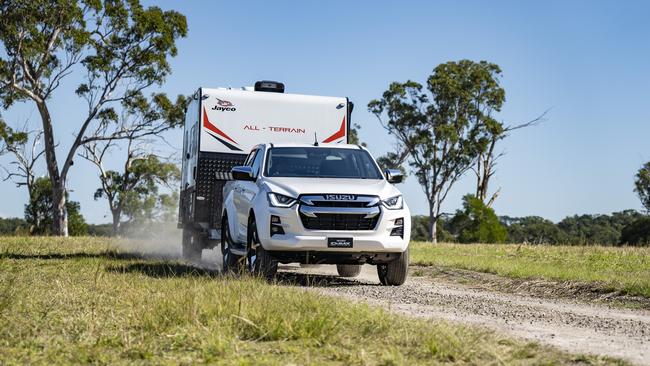
But reliability only gets you so far. Today’s ute buyer wants the latest infotainment and safety kit, plus flashier, SUV-like cabins.
The outgoing D-Max’s utilitarian interior looks painfully dated beside best-selling competitors including Toyota’s HiLux, Ford’s Ranger and Mitsubishi’s Triton.
No longer. This new-generation is rich with quality infotainment and safety, while the
exterior benefits from LED lights and sharper styling.
All D-Max models have wireless Apple CarPlay/wired Android Auto, high-res touchscreens,
advanced auto emergency braking, traffic sign recognition and eight airbags.
In terms of the new model’s features versus old, the D-Max has done a Bradbury.
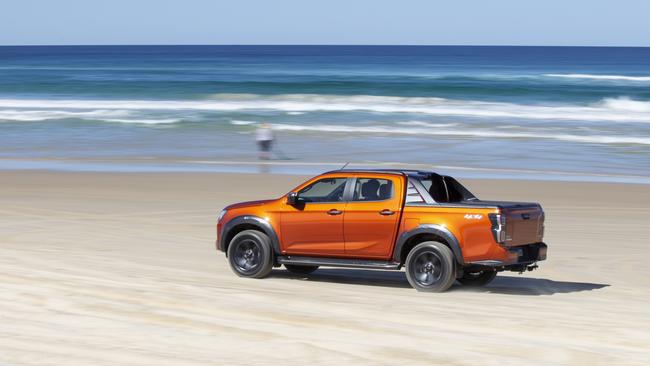
An airbag between driver and passenger shows serious safety credentials. While there is no ANCAP result yet, five stars are expected so the D-Max can be considered by safety-demanding government and business fleets.
The revolution was needed. Many D-Max rivals are soon due updates, including the segment-
leading HiLux and Mazda’s BT-50 (which shares its engine and underpinnings with the Isuzu) arriving imminently.
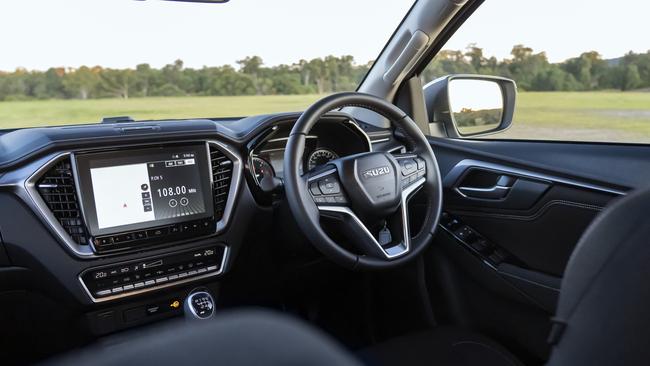
This all comes at a cost. Prices for each grade are up a few grand, including an $8100 leap
for the flagship LS-T, replaced by a shoutier X-TERRAIN nameplate. At $62,990 plus on-roads, it is costlier than Toyota’s HiLux Rogue flagship and the popular Ford Ranger Wildtrak.
Isuzu’s general manager of sales, Ben Jaeger, says Australians were prepared to pay for their
higher-specification appetite.
“We feel we’re priced appropriately against the likes of HiLux and Ranger … we see them as our more natural competitors.”
Grades are SX, LS-M, LS-U and X-Terrain with single cab, space cab and crew (double) cab
styles.
Pricing? Well, things get confusing. Ignore Isuzu’s recommended retail figures as they always do drive-away deals.
Announced so far are $29,990 for the entry SX and $58,990 the X-Terrain – yes, cheaper than the RRPs. Mystifying.
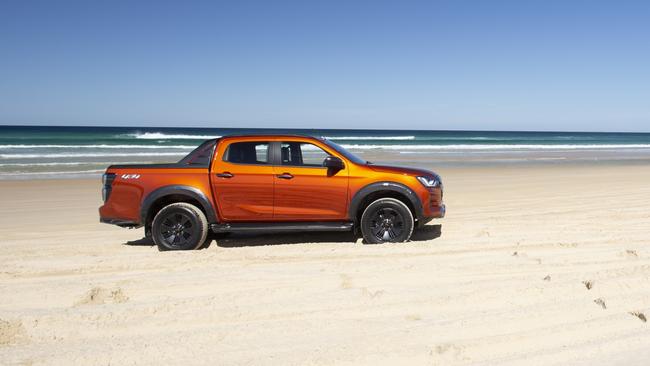
The SX work truck has basic cloth seats, vinyl floor, halogen lights and steel rims; the LS-M
fancier cloth seats, LED lights and 17-inch alloys. Importantly, both score the infotainment
and safety kit previously mentioned, plus auto lights and wipers.
The LS-U gets a leather steering wheel, dual zone climate, carpets, aluminium side steps,
chrome grille and 18-inch two-tone alloys, while X-Terrains gain power leather seats, smart
key with remote engine start, dark grey trim, roof rails, sports bar, side steps, fender flares
and alloys, plus a roller tonneau cover and tub liner. Its “Volcanic Amber” colour adds more
theatre.
There are omissions. You’d expect the X-Terrain to offer heated seats (the $10,000-cheaper
Triton GLS Premium does), while all D-Max buyers are asked for another $1164 for a tow
bar.
ON AND OFF THE ROAD
Blame COVID-19, but we only sampled the LS-U and X-Terrain 4x4 double-cab utes.
There’s been a huge leap in cabin class. Angular styling for the dash, air vents and doors plus
lavish climate control piano keys drag the D-Max into the 2020s. Focal point 9-inch
touchscreens have excellent resolution, although can be slow to get going.
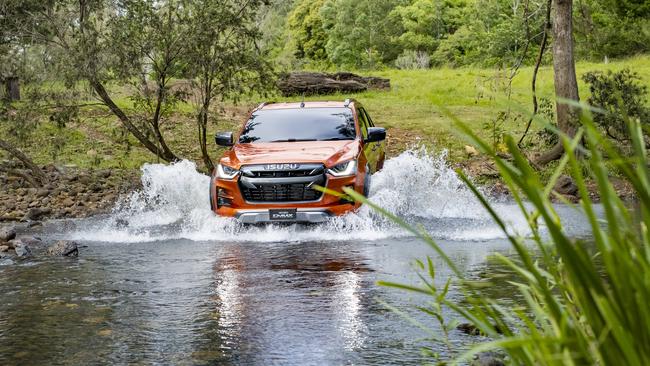
Solid build and fit-for-purpose aspects remain, including hard plastics for the doors and cup
holders in front of the air vents. Two ISOFIX mounting points and rear vents boost its family
vehicle potential.
Fire up the redeveloped truck-based 3.0-litre diesel and this is a more refined, less obtrusive
motor than old. It still roars from cold and when really pushed, despite the well-insulated
cabin, but for general driving it’s an un-stressed lump.
Figures of 140kW/450Nm aren’t segment busting, but impressive driveability arrives in the form of 400Nm punch from just 1400rpm.
It’s great for effortless highway cruising and towing, plus we returned a pleasing 8.2L/100km on-road, only rising to 8.9L/100km during on-sand shenanigans.
As with all one-tonners, leave the tub empty and the ride isn’t as planted as when laden –
970kg is the X-Terrain’s maximum payload, 1065kg the 4x4 LS-U.

Isuzu’s standard three-leaf springs (cheaper models get heavy duty items) give confident control and a less bouncy ride than the just-superseded Toyota HiLux, but don’t expect to corner like a BMW SUV. Keep things sensible and the D-Max’s handling and steering are decent considering its size and mass.
Always dependable in the wilds, the appeal to hardcore off-roaders is raised with a standard
rear diff lock (finally!) on 4x4s, and mighty 800mm wading depth.
Our sand adventure had the Isuzu in its element, ploughing through the soft stuff with little
fuss on highway tyres with highway pressures. The shift from two- to four-wheel-drive is
done on the fly, while a quick knock into neutral when stationary and low range is engaged
in two seconds. Far less clunky than before.
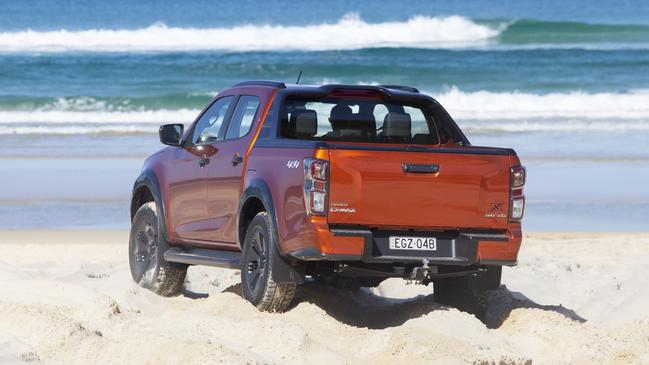
VERDICT 4/5
The D-Max’s price rises were inevitable for technology, safety and driveability gains, but
worth it. Complemented by the revered, improved 3.0-litre engine, this is a far more
resolved package. Some buyers may be dissuaded and opt for the cheaper Mitsubishi Triton,
but this reformed Isuzu’s gunning for HiLux and Ranger blood.
WHAT’S NEW
Price: Big price rises, justified by big specification boost. Entry level 2WD Single Cab Chassis SX’s RRP up $3600 to $32,200; range topping Crew Cab X-Terrain up $8100 to $62,900. RRPs are nonsense, though. The 2WD SX is $29,990 drive-away, X-Terrain is $58,990.
Technology: Android Auto and wireless Apple CarPlay added; 7-inch or 9-inch (top two grades) 1280 x 800 HD screens. Advanced auto emergency braking, adaptive cruise control, speed-sign recognition, lane-keep assist and eight airbags (including a central one) feature range-wide.
Performance: Re-engineered 3.0-litre four-cylinder turbo-diesel is quieter, more refined and has 140kW/450Nm — up 10kW/20Nm. Consumption similar at 7.7L-8.0L/100km (previously 7.2L – 8.1L/100km).
Driving: Improved off-road with rear diff lock on 4x4s, 800mm wading depth (up 200mm) and upgraded Terrain Command System. Larger (320mm) front brakes, lighter and stronger 3-leaf rear suspension, new front suspension and anti-roll bars reduce body roll; electric power steering introduced.
Design: Horizontal bars in larger front grille for a more truck-like look, angled Bi-LED headlights with DRLs, combination LED rear lights, sharper body angles and wide-spoke alloy wheels. Modernised cabin with sharp style lines, fewer hard plastics, digital speedo, two ISOFIX points
ISUZU D-MAX VITALS
Price: $29,990 – $58,990 drive-away
Warranty/servicing: 6 years/150,000 km; services every 15,000km/12 months, $3373 for 7 years/105,000km
Engine: 3.0-litre 4-cyl turbo-diesel, 140kW/450Nm
Safety: Untested (5 stars expected), 8 airbags, auto emergency braking, forward collision warning, lane keep assist, lane departure prevention and warning, turn assist with AEB, emergency stop signal, adaptive cruise control, traffic sign recognition, blind spot monitor, rear camera, rear cross traffic alert
Thirst: 7.7-8.0L/100km
Towing: 3500kg
Spare: Full-size
Originally published as New Isuzu D-Max ute review: Big upgrades push workhorse to front of the pack
